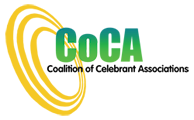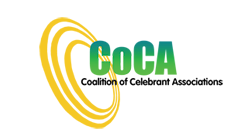|
NUMBER |
TITLE |
|
|
COCA-CHCCEL008 |
Identify needs, setup and maintain resources for the Professional Celebrancy Practice |
|
|
Application |
This unit describes the skills and knowledge required to Identify needs, setup and maintain range of computer and/or IT based hardware and software resources for the professional celebrancy practice priorities |
|
|
ELEMENT |
PERFORMANCE CRITERIA |
|
|
Identify and assess celebrant IT and computer associated devices needs and objectives in the celebrancy role |
· Identify, understand and communicate how changing technologies, especially the move to “paperless” societies, are impacting on ceremonies, clients and the role of the celebrant in performing their current roles and how this may impact one’s practice over time · Identify and list various changes to technologies the last decade e.g. from fax machines to Cloud storage · Assess the specific ways in which ceremony and related celebrancy work has been and will be affected by changing technologies · Identify and implement IT, computer and associated devices needed for celebrancy practice and strategies to ensure celebrant continues to remain up-to-date with changes in technology |
|
|
Plan for, and assess personal computer and associated devices needs for celebrancy practice |
· Demonstrate a basic understanding of computer technology by creating a glossary of terms to be used to communicate with other users in specific terms and language · Identify and name the differences of the two common personal computer operating systems in terms of their functionality and other factors · Research and analyse the advantages and disadvantages of each operating system · Identify the full range of hardware and software requirements relevant to a celebrant’s practice
· Research and determine software compatibility issues · Compare and analyse pricing and payment options to determine the most suitable information and communications technology goods and services for the business |
|
|
Identify, understand and use internet technologies for a full range of celebrancy work practices |
|
|
|
Identify and use electronic information collection, organisation, storage and retrieval systems |
|
|
|
Understand the need for, and use of IT and computer technology security and maintenance systems |
|
|
|
Be competent and efficient in the use of office/business suites relevant to personal computer operating system. |
|
|
|
Identify mobile technologies suitable for celebrants’ practice, plan and implement when possible those to improve the efficiently and flexibility of services provided. |
|
|
|
Identify, assess and access, as required, support networks: celebrancy specific and others – paid and free |
Research, identify and list ‘user groups’ in relation to specific software programs relevant to celebrancy Research, identify and list other ‘online’ support networks relevant to a celebrant business |
|
|
|
||
|
Foundation skills essential to performance are explicit in the performance criteria of this unit of competency. |
||
|
UNIT MAPPING INFORMATION No equivalent unit |
|
LINKS www.cshisc.com.au |
|
ASSESSMENT REQUIREMENTS for |
||
|
The assessment requirements provide advice on assessment and must be read in conjunction with the specific detail of this unit of competency and related assessment information for this Training Package. |
||
|
Performance evidence |
The candidate must show evidence of the ability to complete tasks outlined in elements and performance criteria of this unit, manage tasks and manage contingencies in the context of the job role. There must be evidence that the candidate has: |
|
|
Demonstrated the ability to use computers, iPads or equivalent, to write and store documents, invoices, receipts and other business related material Demonstrated the ability to use mobile phones to receive and retrieve messages Recorded professional and appropriate voices mail/ messages for clients when unable to respond to incoming call Set-up and have used internet based communications and web technology, including: o Email accounts, email aliases and email signatures. o Send and received emails from own mail box and web mail. o Located and downloaded appropriate web-browsers, conduct web searches to locate poetry, prose, locate venues and plan the journeys to and from the venue. o A web listing in free online directories, including editing o Register and use online forums and groups for celebrant and other association support and continuing professional development. o Used online portals and access pass worded protected websites, demonstrating safe and accessible storage of passwords Created, by using a template in a software program upon acquisition of the personal computer, or via a commercial subscription to PC manufacturer equivalent, the following:
Demonstrated the ability to organize, archive and safely store essential information using technology and equipment, e.g., virus software, back-up storage of important documents, using internal and external devices Created diaries and records for work incoming, including schedules and automatic reminders to ensure compliance with Code of Practice and provide examples of record keeping methods Demonstrated an understanding of, and documented strategies for:
|
||
|
Knowledge evidence |
The candidate must be able to demonstrate essential knowledge required to effectively complete tasks outlined in elements and performance criteria of this unit, manage tasks and manage contingencies in the context of the work role. This includes knowledge of: |
|
|
The impact on changing technologies, especially to “paperless” societies, on ceremonies, clients and the role of the celebrant in performing their current roles How this may impact celebrant's practice over time, including various changes to technologies the last decade. The specific ways in which ceremony and related celebrancy work has been, and will be affected by changing technologies The full range of hardware and software requirements and associated devices needed for celebrancy practice and strategies to ensure the celebrant continues to remain up-to-date with changes in technology. Communication mechanisms such as:
Compiled a glossary of terms used with computers in specific terms and language dedicated to online PC security, eg. hacking, phishing, Trojans, encryption
Shown the difference between the two common personal computer operating systems in terms of their functionality and other factors The advantages and disadvantages of each operating system and software compatibility issues for your celebrant practice How to access suitable suppliers of hardware and software and appropriate support services for their purchase and maintenance in your area Compiled a glossary of terms related to the internet and world wide web, in specific terminology and language. Documented the latest generation of browsers/search engines, the difference between browsers and those appropriate for your celebrant business applications Documented the criteria in choosing appropriate ISP, IT/hosting and antivirus software providers, in particular their support services, after acquisition Documented the methodology for web search strategies for a range of celebrancy needs including making informed decisions on correct key words and terms when browsing websites and how to trouble shoot hyperlinks Documented the methodology for identifying reliable and verifiable sources of electronic information, such as legislative, industry and/or association based information Documented the availability of online tutorials for expanding web skills – commercial versus free Documented the methodology for determining the functionality and application of various directories relevant to celebrants Documented how to access support networks celebrancy specific and other – paid and free Documented how to use suitable naming protocols for labelling files with material electronically stored. Identify types of files by their extensions eg, pdf, docx Documented legal and other requirements surrounding the storage of information electronically Created a Database – commercial versus in-house, eg Microsoft Access or Mac dBase Documented suitable storage issues and retention/deletion policies Documented the advantages and disadvantages of Cloud storage versus other methods of back up, eg. thumb drives, CDs, external hard drives Documented the essential steps to protect and keep data safe, and ensuring internet and computer safety Documented knowledge of firewalls, passwords (storage and access), in particular when considering the acquisition of commercial anti-virus programs Commonly used programs for email, document creation, spreadsheets and databases. Documented new technologies suitable for your celebrant practice Created a glossary of terminology relevant to mobile devices e.g., tablets, iPads etc, including defining “apps”, and their operations Documented User groups in relation to specific software programs relevant to celebrancy. Other ‘online’ support networks relevant to your celebrant business Documented relevant legislative and statutory requirements and provisions relating to celebrancy services - Intellectual property, Copyright, confidentiality of client information, WHS requirements, standards, Code of Conduct and ethics relevant to celebrancy and a brief description of each |
||
|
Assessment conditions |
Skills must have been demonstrated in the workplace or in a simulated environment that reflects workplace conditions. The following conditions must be met for this unit: |
|
|
TBA |
||
|
Assessors must satisfy the NVR/AQTF mandatory competency requirements for assessors |
||
|
LINKS www.cshisc.com.au |
||


